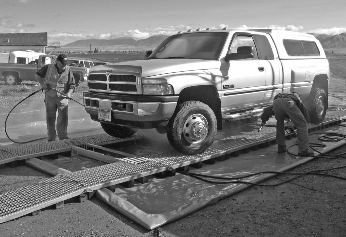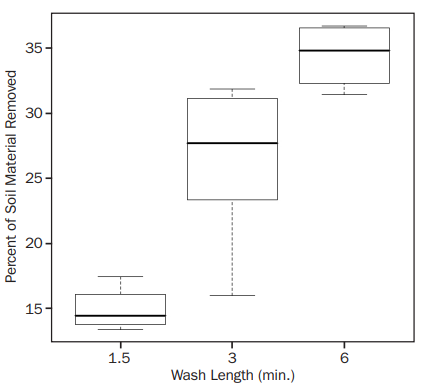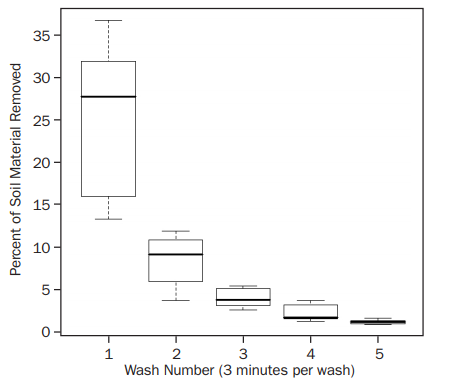
Washing Vehicles to Prevent Weed Seed Dispersal
Vehicle washing is an effective strategy for preventing vehicular spread of weeds. A wash of 6 minutes was most effective for cleaning a vehicle. And, an evaluation of five commercial wash units found that about 77 percent of soil and other debris was removed from three different types of vehicle.
Last Updated: 04/17by Kimberley Taylor, Fredric Pollnac and Tyler Brummer, Graduate Research Assistants; Jane Mangold, MSU Extension Noxious Weed Specialist; and Lisa J. Rew, Assistant Professor, Department of Land Resources and Environmental Sciences
WEED INFESTATIONS ARE GENERALLY MORE
frequent along roadsides and other disturbed areas than in adjacent land, possibly because vehicles spread seeds into these areas and such areas provide suitable habitats for weed growth. Many types of vehicles, including passenger cars, 4-wheel drive (4WD) trucks, agricultural implements, tracked vehicles and all- terrain vehicles (ATVs) have been found to pick up seeds. Transport and spread of weeds via vehicles is a concern for many land managers because management activities often involve moving vehicles or equipment from site to site. A recent study showed that once seeds become attached to a vehicle, they can travel for hundreds of miles under dry conditions before falling off, whereas seed loss is more rapid under wet conditions and on unpaved roads (see Extension publication, Weed Seed Dispersal by Vehicles, MT201105AG).
Weeds spread by vehicles may harm ecosystems by outcompeting native plants, productive forage species, or agricultural crops and by altering ecosystem process and function. In 1999 a Presidential Executive Order was issued that directs Federal agencies to take whatever measures are available to minimize transport of non-indigenous species. The Department of Defense (DoD) and United States Department of Agriculture Forest Service (USFS) have responded to this order by cleaning vehicles with commercial wash units to avoid transporting non-indigenous species to other areas. Commercial vehicle wash units typically clean mud and debris from vehicles using undercarriage washers and high-pressure hand sprayers (Figure 1). The wash water is then subjected to an extended filtration and settling process, aimed at removing waste (sediment and other large particles) from the water so that it can either be reused for future washes or discarded. Vehicle washing is appropriate, given that it is more cost-effective to prevent weed invasions than to control infestations have already begun, particularly in range- and wild-lands. Various wash lengths and vehicle wash that units are currently used; however, no standards have been developed. We conducted a series of studies to determine optimal washing duration and test the effectiveness of five commercial portable vehicle wash units with the goal of determining the most effective vehicle washing protocol.

FIGURE 1. Truck being washed by a commercial wash unit as part of the vehicle washing experiments. The truck is driven along the elevated racks while being cleaned by undercarriage washers and hand held pressure hoses.
Field Studies
The ideal duration and number of washes necessary to clean a vehicle were evaluated in two separate studies. A third study compared the effectiveness of five different commercial portable wash units for cleaning various types of vehicles.
Vehicle wash duration.
The first study evaluated how much soil and other debris is removed from a vehicle by washes of different durations using a commercial wash unit with undercarriage wash attachments and two high pressure hoses. A known amount of soil was sprayed onto the underside of a meticulously clean pickup truck and allowed to dry for 12 hours. The truck was then washed for 1.5, 3, or 6 minutes. At the end of each wash, soil removed from the truck was collected. This soil was then dried, weighed, and compared to the amount of dry soil applied to the truck to determine what percent of the applied soil was removed during each of the washes.
Number of vehicle washes.
To evaluate how the number of washes affects soil removal, a similar study was conducted by again spraying a known amount of soil onto the underside of a clean pickup. This truck was then driven directly to the same wash unit and washed for 3 minute intervals, providing total wash times of 3, 6, 9, 12 and 15 minutes. The soil collected from each wash was dried and weighed to determine how much soil was removed by each successive wash.
It should be noted that for both of these experiments fine filters (200 microns) were used as part of the wash system, however, such a filter does allow some particles to be lost thereby reducing the amount of soil matter available for recapture.

FIGURE 2. Percent soil material removed from a muddied truck during washes of different durations. There were 4 replicates for the 1.5 and 6 minute wash and 6 replicates for the 3 minute wash.*
Wash unit comparison.
We compared the effectiveness of five commercial portable wash units that differed in water pressure and water use levels on three different vehicle types (tracked bulldozer, off-road fire engine, and light 4WD vehicle). Four of the units had undercarriage wash attachments and all had pressurized hand hoses. Before the study began, the test vehicles were cleaned meticulously and then driven 1 mile at 10 to 15 miles/hour on a figure-eight course that contained an off-road section with a mud bog and was accessed via a gravel road. Vehicles were washed for five minutes by the commercial wash unit and then by the USFS crew. The tracked bulldozer underwent a modified routine and was transported on a trailer to the off-road section of the course and driven around the 0.4 mile test area. The bulldozer was then returned to the trailer and washed by the commercial wash unit for 60 minutes (as per normal commercial practice), after which it was cleaned by the USFS washing crew.
The soil and other debris collected from each vehicle type by each commercial wash unit was dried and weighed, as was the soil and other debris collected during the follow-up USFS washes. At the end of each commercial wash unit test (18 cycles for each wheeled vehicle type and once for tracked), each vehicle was returned to the USFS elevated rack for a meticulous inspection with wheels removed as appropriate, and additional cleaning performed to remove any remaining soil. This soil was dried, weighed and combined with the soil from the follow-up USFS washes to determine the total amount of soil and other debris not dislodged by the commercial vehicle washing units.

FIGURE 3. Percent soil material removed from a muddied truck during five successive three minute washes.*

FIGURE 4. Percent of soil material removed by vehicle type for five commercial wash units.
Results
Vehicle wash duration.
Longer duration single wash times resulted in more soil being removed than a single 1.5 minute wash. The average percent of total soil removed from trucks differed between wash times (Figure 2), with the 6 minute wash removing the most soil and the 3 minute wash removing more soil than the 1.5 minute wash.
Number of vehicle washes.
Our study showed that an additional amount of soil was removed with each successive wash. However, after the third wash (9 minutes in total) only small amounts of soil were removed (Figure 3), again demonstrating that a 6 minute wash was most effective.
Wash unit comparison.
Evaluation of the five commercial vehicle wash units showed a relatively high efficiency (66 percent to 95 percent of soil removed) for all units (Figure 4). Wash units had higher soil removal efficiencies for the bulldozer, likely because it was washed for longer than the other vehicles. While there was some variability between wash units, overall the units performed similarly with a trend that larger vehicles were cleaned more effectively than the smaller vehicles.
Conclusion
Our results showed that wash length and number of washes is important when cleaning a vehicle to remove soil that may contain weed seeds. Vehicles washed for 6 minutes in one wash or two to three successive 3 minute washes were the cleanest. If time is limited, a 3 minute wash still removes much more soil material than a 1.5 minute wash which is considered standard by some wash unit operators. All commercial wash units, regardless of water pressure or water use, performed similarly. Vehicle wash units represent an effective solution for removing soil and other debris from vehicles before entering weed free areas, or after leaving weed infested areas. Their mobility and durability make them ideal for situations where space is limited and a large number of vehicles need to be cleaned.
To order additional publications, please contact your county or reservation MSU Extension office, visit our online catalog at store.msuextension.org or e-mail orderpubs@montana.edu

